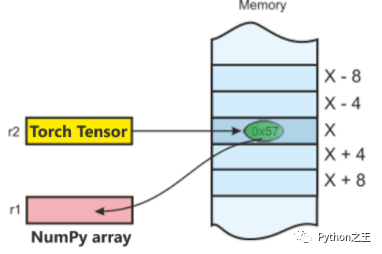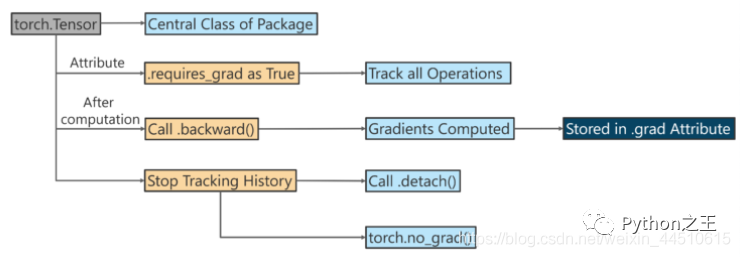什么是 PyTorch?
PyTorch是一个基于Python的科学计算包,提供最大灵活性和速度的深度学习研究平台。
张量
张量类似于NumPy 的n 维数组,此外张量也可以在 GPU 上使用以加速计算。
让我们构造一个简单的张量并检查输出。首先让我们看看我们如何构建一个 5×3 的未初始化矩阵:
- import torch
- x = torch.empty(5, 3)
- print(x)
输出如下:
- tensor([[2.7298e+32, 4.5650e-41, 2.7298e+32],
- [4.5650e-41, 0.0000e+00, 0.0000e+00],
- [0.0000e+00, 0.0000e+00, 0.0000e+00],
- [0.0000e+00, 0.0000e+00, 0.0000e+00],
- [0.0000e+00, 0.0000e+00, 0.0000e+00]])
现在让我们构造一个随机初始化的矩阵:
- x = torch.rand(5, 3)
- print(x)
输出:
- tensor([[1.1608e-01, 9.8966e-01, 1.2705e-01],
- [2.8599e-01, 5.4429e-01, 3.7764e-01],
- [5.8646e-01, 1.0449e-02, 4.2655e-01],
- [2.2087e-01, 6.6702e-01, 5.1910e-01],
- [1.8414e-01, 2.0611e-01, 9.4652e-04]])
直接从数据构造张量:
- x = torch.tensor([5.5, 3])
- print(x)
输出:
- tensor([5.5000, 3.0000])
创建一个统一的长张量。
- x = torch.LongTensor(3, 4)
- x
- tensor([[94006673833344, 210453397554, 206158430253, 193273528374],
- [ 214748364849, 210453397588, 249108103216, 223338299441],
- [ 210453397562, 197568495665, 206158430257, 240518168626]])
「浮动张量。」
- x = torch.FloatTensor(3, 4)
- x
- tensor([[-3.1152e-18, 3.0670e-41, 3.5032e-44, 0.0000e+00],
- [ nan, 3.0670e-41, 1.7753e+28, 1.0795e+27],
- [ 1.0899e+27, 2.6223e+20, 1.7465e+19, 1.8888e+31]])
「在范围内创建张量」
- torch.arange(10, dtype=torch.float)
- tensor([0., 1., 2., 3., 4., 5., 6., 7., 8., 9.])
「重塑张量」
- x = torch.arange(10, dtype=torch.float)
- x
- tensor([0., 1., 2., 3., 4., 5., 6., 7., 8., 9.])
使用 .view重塑张量。
- x.view(2, 5)
- tensor([[0., 1., 2., 3., 4.],
- [5., 6., 7., 8., 9.]])
-1根据张量的大小自动识别维度。
- x.view(5, -1)
- tensor([[0., 1.],
- [2., 3.],
- [4., 5.],
- [6., 7.],
- [8., 9.]])
「改变张量轴」
改变张量轴:两种方法view和permute
view改变张量的顺序,而permute只改变轴。
- x1 = torch.tensor([[1., 2., 3.], [4., 5., 6.]])
- print("x1: \n", x1)
- print("\nx1.shape: \n", x1.shape)
- print("\nx1.view(3, -1): \n", x1.view(3 , -1))
- print("\nx1.permute(1, 0): \n", x1.permute(1, 0))
- x1:
- tensor([[1., 2., 3.],
- [4., 5., 6.]])
- x1.shape:
- torch.Size([2, 3])
- x1.view(3, -1):
- tensor([[1., 2.],
- [3., 4.],
- [5., 6.]])
- x1.permute(1, 0):
- tensor([[1., 4.],
- [2., 5.],
- [3., 6.]])
张量运算
在下面的示例中,我们将查看加法操作:
- y = torch.rand(5, 3)
- print(x + y)
输出:
- tensor([[0.5429, 1.7372, 1.0293],
- [0.5418, 0.6088, 1.0718],
- [1.3894, 0.5148, 1.2892],
- [0.9626, 0.7522, 0.9633],
- [0.7547, 0.9931, 0.2709]])
调整大小:如果你想调整张量的形状,你可以使用“torch.view”:
- x = torch.randn(4, 4)
- y = x.view(16)
- # 大小-1是从其他维度推断出来的
- z = x.view(-1, 8)
- print(x.size(), y.size(), z.size())
输出:
- torch.Size([4, 4]) torch.Size([16]) torch.Size([2, 8])
PyTorch 和 NumPy的转换
NumPy 是Python 编程语言的库,增加了对大型、多维数组和矩阵的支持,以及对这些数组进行操作的大量高级数学函数集合。
将Torch中Tensor 转换为 NumPy 数组,反之亦然是轻而易举的!
Torch Tensor 和 NumPy 数组将共享它们的底层内存位置 ,改变一个将改变另一个。
「将 Torch 张量转换为 NumPy 数组:」
- a = torch.ones(5)
- print(a)
输出:tensor([1., 1., 1., 1., 1.])
- b = a.numpy()
- print(b)
输出:[1., 1., 1., 1., 1.]
让我们执行求和运算并检查值的变化:
- a.add_(1)
- print(a)
- print(b)
输出:
- tensor([2., 2., 2., 2., 2.])
- [2. 2. 2. 2. 2.]
「将 NumPy 数组转换为 Torch 张量:」
- import numpy as no
- a = np.ones(5)
- b = torch.from_numpy(a)
- np.add(a, 1, out=a)
- print(a)
- print(b)
输出:
- [2. 2. 2. 2. 2.]
- tensor([2., 2., 2., 2., 2.], dtype=torch.float64)
所以,正如你所看到的,就是这么简单!
接下来在这个 PyTorch 教程博客上,让我们看看PyTorch 的 AutoGrad 模块。
AutoGrad
该autograd包提供自动求导为上张量的所有操作。
它是一个按运行定义的框架,这意味着您的反向传播是由您的代码运行方式定义的,并且每次迭代都可以不同。
- torch.autograd.function (函数的反向传播)
- torch.autograd.functional (计算图的反向传播)
- torch.autograd.gradcheck (数值梯度检查)
- torch.autograd.anomaly_mode (在自动求导时检测错误产生路径)
- torch.autograd.grad_mode (设置是否需要梯度)
- model.eval() 与 torch.no_grad()
- torch.autograd.profiler (提供 function 级别的统计信息)
「下面使用 Autograd 进行反向传播。」
如果requires_grad=True,则 Tensor 对象会跟踪它是如何创建的。
- x = torch.tensor([1., 2., 3.], requires_grad = True)
- print('x: ', x)
- y = torch.tensor([10., 20., 30.], requires_grad = True)
- print('y: ', y)
- z = x + y
- print('\nz = x + y')
- print('z:', z)
- x: tensor([1., 2., 3.], requires_grad=True)
- y: tensor([10., 20., 30.], requires_grad=True)
- z = x + y
- z: tensor([11., 22., 33.], grad_fn=<AddBackward0>)
因为requires_grad=True,z知道它是通过增加两个张量的产生z = x + y。
- s = z.sum()
- print(s)
- tensor(66., grad_fn=<SumBackward0>)
s是由它的数字总和创建的。当我们调用.backward(),反向传播从s开始运行。然后可以计算梯度。
- s.backward()
- print('x.grad: ', x.grad)
- print('y.grad: ', y.grad)
- x.grad: tensor([1., 1., 1.])
- y.grad: tensor([1., 1., 1.])
下面例子是计算log(x)的导数为1 / x
- import torch
- x = torch.tensor([0.5, 0.75], requires_grad=True)
- # 1 / x
- y = torch.log(x[0] * x[1])
- y.backward()
- x.grad # tensor([2.0000, 1.3333])
【编辑推荐】






























